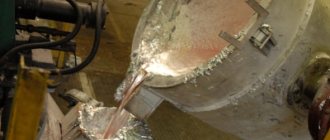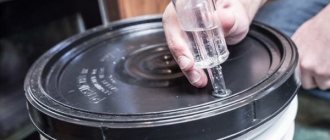Energy is constantly becoming more expensive, paying bills is becoming more and more difficult, you have to either save money or invent new technologies for extracting energy resources. Take your time! In Ancient China they already thought of this before you. Over time, designs for domestic consumption of the generated fuel became irrelevant. Today we remembered them. After all, kilowatts of free energy are found in literally every private homestead or farm.
You can recycle waste and turn it into biofuel. Small bacteria do all the work themselves; they only need to create suitable conditions, for which they need to prepare a special biogas installation, into which the access of oxygen must be blocked.
The principle of operation of the bioreactor
Schematic diagram of a biogas plant
The bioreactor operates on organic waste, so for its continuous operation a constant presence of manure and other agricultural waste is necessary. The biogas produced by the installation is a biologically clean fuel, and its performance is similar to natural gas.
The job of a bioreactor is to process organic waste into gas and fertilizer. To do this, they are loaded into a bioreactor tank, where anaerobic bacteria process the biomass. To achieve proper fermentation, air must not enter the tank. Processing time depends on the volume of loaded waste. The released gas consists of 60% methane and 35% carbon dioxide. Other impurities account for 5%. The resulting gas is purified and is then ready for use in household appliances.
Note! The recycled material is removed from the tank and used as fertilizer in agriculture, and new waste is loaded in its place.
Raw materials for production
When rotting and heating, organic substances produce heat, and the gas output is uneven. We provide a list of raw materials (in ascending order) that are most often used in biogas production, in m3/t:
- whey from milk, fruit and vegetable cake (up to 70);
- animal excrement and bird droppings (from 60 to 130);
- corn and fish waste (up to 300);
- remains of killed animals, waste from slaughterhouses (up to 320);
- freshly cut grass (up to 350);
- glycerin for technical needs (up to 500);
- grain crops (up to 600);
- fat (up to 1300).
On farms, such an installation is indispensable:
- firstly, there is no need to remove and dispose of waste;
- secondly, a high percentage of biogas output will allow significant savings on space heating;
- thirdly, biomass rotted in the plant is an excellent fertilizer.
A biogas plant requires effort, materials and time, but it pays for itself in literally 1 year.
Design of a simple bioreactor
The simplest bioreactor device
The simplest device that you can build with your own hands consists of a reactor for processing, a loading tank, an entrance hatch, a hatch for collecting waste waste, a water seal, and a gas exhaust pipe. For a better idea, there is a diagram of a bioreactor in a simple design.
The bioreactor is made of reinforced concrete or a metal container and installed in a selected area of the yard. The most important thing is that the installation is completely sealed. The size of the tank depends on the constant amount of waste available for processing, which is loaded at 2/3 of its size. For reference: from 1 ton of waste during processing, 100 m3 of gas is obtained. Based on these calculations, it is not advisable to install a small container. After all, the amount of gas obtained depends on the amount of waste loaded for processing. One of the main devices on the tank is the waste collection hatch, which must be sealed.
Note! Spent waste must be constantly unloaded. To ensure that the hatch does not become deformed due to frequent opening, and there is no gas leakage, it is necessary to provide for its reliable design.
Particular attention should be paid to the construction of the reservoir. The walls and bottom must have a solid concrete base. During pouring, reinforcement must be performed. After the solution has hardened, the surface is treated with waterproofing agents. The top of the tank is made of refractory brick laid on a metal frame.
World after the end of the world
Has everyone seen Mad Max 3: Beyond Thunderdome? Then we read another copy-paste taken from here: https://serhii.my1.ru/publ/stati_dr_avtorov/biogaz_…
Biogas. Producing methane at home.
What is biogas?
Recently, non-traditional, from a technical point of view, energy sources have been attracting more and more attention: solar radiation, sea tides and waves, and much more. Some of them, such as wind, were widely used in the past, and today are experiencing a rebirth. One of the “forgotten” types of raw materials is biogas, which was used in Ancient China and “discovered” again in our time.
What is biogas? This term refers to a gaseous product obtained as a result of anaerobic, that is, fermentation (overheating) of organic substances of various origins occurring without access to air. Any peasant farm collects a significant amount of manure, plant tops, and various wastes throughout the year. Typically, after decomposition, they are used as organic fertilizer. However, few people know how much biogas and heat is released during fermentation. But this energy can also serve rural residents well.
Biogas is a mixture of gases. Its main components: methane (CH4) - 55-70% and carbon dioxide (CO2) - 28-43%, as well as other gases in very small quantities, for example hydrogen sulfide (H2S).
On average, 1 kg of organic matter that is 70% biodegradable produces 0.18 kg of methane, 0.32 kg of carbon dioxide, 0.2 kg of water and 0.3 kg of non-decomposable residue.
Factors influencing biogas production.
Since the decomposition of organic waste occurs due to the activity of certain types of bacteria, the environment has a significant influence on it. Thus, the amount of gas produced largely depends on temperature: the warmer it is, the higher the speed and degree of fermentation of organic raw materials. This is probably why the first installations for producing biogas appeared in countries with warm climates. However, the use of reliable thermal insulation, and sometimes heated water, makes it possible to master the construction of biogas generators in areas where the temperature in winter drops to -20? C. There are certain requirements for raw materials: it must be suitable for the development of bacteria, contain biodegradable organic matter and a large amount of water (90-94%). It is desirable that the environment be neutral and free of substances that interfere with the action of bacteria: for example, soap, washing powders, antibiotics.
To produce biogas, you can use plant and household waste, manure, sewage, etc. During the fermentation process, the liquid in the tank tends to separate into three fractions. The upper crust, formed from large particles carried away by rising gas bubbles, after some time can become quite hard and will interfere with the release of biogas. Liquid accumulates in the middle part of the fermenter, and the lower, mud-like fraction precipitates.
Bacteria are most active in the middle zone. Therefore, the contents of the tank must be stirred periodically - at least once a day, and preferably up to six times. Mixing can be carried out using mechanical devices, hydraulic means (recirculation by a pump), under the pressure of a pneumatic system (partial recirculation of biogas) or using various self-mixing methods.
Installations for biogas production.
In Romania, biogas generators are widely used. One of the first individual installations (Fig. 1A) was put into operation in December 1982. Since then, it has successfully provided gas to three neighboring families, each with a conventional gas stove with three burners and an oven. The fermenter is located in a pit with a diameter of about 4 m and a depth of 2 m (volume approximately 21 m3), lined from the inside with roofing iron, welded twice: first with electric welding, and then, for reliability, with gas welding. For anti-corrosion protection, the inner surface of the tank is coated with resin. Outside the upper edge of the fermenter, a circular groove of concrete approximately 1 m deep is made, which serves as a water seal; in this groove, filled with water, the vertical part of the bell that closes the reservoir slides.
The bell, about 2.5 m high, is made of two-millimeter steel sheet. Gas collects in its upper part.
The author of this project chose the option of collecting gas, unlike other installations, using a pipe located inside the fermenter and having three underground branches - to three farms. In addition, the water in the groove of the water seal is flowing, which prevents icing in winter. The fermenter is loaded with approximately 12 m3 of fresh manure, on top of which cow urine is poured (without adding water. The generator starts working 7 days after filling.
Another installation has a similar layout (Fig. 1B). Its fermenter is made in a pit with a square cross-section measuring 2x2 and a depth of approximately 2.5 m. The pit is lined with reinforced concrete slabs 10-12 cm thick, plastered with cement and covered with resin for tightness. The water seal groove, about 50 cm deep, is also concrete, the bell is welded from roofing iron and can slide freely on four “ears” along four vertical guides installed on the concrete tank. The height of the bell is approximately 3 m, of which 0.5 m is immersed in the groove.
During the first filling, 8 m3 of fresh cow manure was loaded into the fermenter, and approximately 400 liters of cow urine was washed on top. After 7-8 days, the installation was already fully providing the owners with gas.
The biogas generator, designed to receive 6 m3 of mixed manure (from cows, sheep and pigs), has a similar design. This was enough to ensure normal operation of a gas stove with three burners and an oven.
Another installation is distinguished by an interesting design detail: three large tractor chambers connected to it using a T-shaped hose and connected to each other are placed next to the fermenter (Fig. 2). At night, when biogas is not used and accumulates under the bell, there is a danger that the bell will tip over due to excess pressure. The rubber reservoir serves as additional capacity. A fermenter measuring 2x2x1.5 m is quite enough to operate two burners, and by increasing the useful volume of the installation to 1 m3, you can obtain an amount of biogas sufficient to heat a home.
A special feature of this installation option is the construction of a 138 cm bell with a height of 150 cm made of rubberized fabric, used for the manufacture of inflatable boats. The fermenter is a metal tank 140x380 cm and has a volume of 4.7 m3. The bell is inserted into the manure located in the fermenter to a depth of at least 30 cm to provide a hydraulic barrier to the release of biogas into the atmosphere. At the top of the swelling tank there is a tap connected to a hose; Through it, gas flows to a gas stove with three burners and a column for heating water. To ensure optimal conditions for the operation of the fermenter, manure is mixed with hot water. The installation showed the best results at a raw material humidity of 90% and a temperature of 30-35°.
The greenhouse effect is also used to heat the fermenter. A metal frame is built over the container, which is covered with plastic film: in unfavorable weather conditions, it retains heat and can significantly speed up the process of decomposition of raw materials.
In Romania, biogas generators are also used in state or cooperative farms. Here's one of them. It has two fermenters with a capacity of 203 m3, covered with a frame with polyethylene film (Fig. 3). In winter, the manure is heated with hot water. The installation capacity is 300-480 m3 of gas per day. This quantity is quite enough to meet all the needs of the local agro-industrial complex.
Practical advice.
As already noted, a decisive role. Temperature plays a role in the development of the fermentation process: heating the raw material from 15? up to 20° can double energy production. Therefore, generators often have a special raw material heating system, but most installations are not equipped with it; they use only the heat generated during the process of decomposition of organic substances. One of the most important conditions for the normal operation of the fermenter is the presence of reliable THERMAL INSULATION. In addition, it is necessary to minimize heat loss when cleaning and filling the fermenter hopper.
It is also necessary to remember the need to ensure biochemical balance. Sometimes the rate of production of acids by bacteria is higher than the rate of their consumption by bacteria of the second group. In this case, the acidity of the mass increases, and the production of biogas decreases. The situation can be corrected either by reducing the daily portion of the raw material, or by increasing its solubility (if possible, with hot water), or, finally, by adding a neutralizing substance - for example, milk of lime, washing or drinking soda.
Biogas production may decrease due to the imbalance between carbon and nitrogen. In this case, substances containing nitrogen are introduced into the fermenter - urine or a small amount of ammonium salts, usually used as chemical fertilizers (50 - 100 g per 1 m3 of raw materials).
It should be remembered that high humidity and the presence of hydrogen sulfide (the content of which in biogas can reach 0.5%) stimulate increased corrosion of the metal parts of the installation. Therefore, the condition of all other elements of the fermenter should be regularly monitored and carefully protected in places of damage: best with red lead - in one or two layers, and then two more layers of any oil paint.
Both pipes (metal or plastic) and rubber hoses can be used as a pipeline for transporting biogas from the outlet pipe in the upper part of the installation bell to the consumer. It is advisable to conduct them in a deep trench to prevent ruptures due to freezing of condensed water in winter. If gas is transported using a hose by air, then a special device is needed to drain the condensate. The simplest diagram of such a device is a U-shaped tube connected to the hose at its lowest point (Fig. 4). The length of the free tube branch (x) must be greater than the biogas pressure expressed in millimeters of water. As condensate from the pipeline drains into the tube, water flows out through its free end without gas leakage.
In the upper part of the bell, it is also advisable to provide a pipe for installing a pressure gauge in order to judge the amount of accumulated biogas by the pressure value.
Experience in operating plants has shown that using a mixture of different organic substances as a raw material produces more biogas than when loading the fermenter with one of the components. It is recommended to slightly reduce the humidity of raw materials in winter (to 88-90%) and increase it in summer (92-94%). The water used for dilution should be warm (preferably 35-40°).
Raw materials are served in portions at least once a day. After the first loading of the fermenter, it is often the case that biogas is first produced, which contains more than 60% carbon dioxide and therefore does not burn. This gas is removed into the atmosphere, and after 1-3 days the installation will begin to function normally.
Biomass heating
In warm regions you can do without heating
The constant operation of the reactor depends on the activity of bacteria that cause fermentation of biomass. In a cold mass they are in dormant mode. Once it is heated to the required temperature, the bacteria will resume their work. The optimal fermentation temperature is +38ºС. In warm regions, the outside air temperature is sufficient for the reactor to operate without heating. And for cold regions you will have to install a heating system. A heating coil installed under the container can solve this problem. It is connected to the heating system and taps (or a thermostat) regulate the circulation of hot water to maintain the desired temperature.
Note! Also, as an option, you can install a coil with electric heating elements. They are connected to an automation system that regulates the heating temperature. To do this, you can use conventional automation from water heating boilers.
Usage
Biofuel is most often used for domestic purposes for:
- heating a home or farm;
- heating water for domestic needs.
It is not advisable to use this fuel option for cooking, since the specific smell can be absorbed by food, and the food will have an unpleasant aftertaste.
As you can see, the manufacturing process of the installation is quite simple. Save and always be warm, regardless of energy prices. In this case, the labor costs are justified.
Mixer for bioreactor
Mixing system
During operation of the reactor, for better bacterial activity, the raw material must be stirred periodically. This role can be performed by a device in the form of a mixer. Its blades are located inside the container, and the shaft goes outside. The mixer is driven by an electric motor. At the point where the shaft exits there should be seals that maintain the tightness of the chamber.
Note! In some cases, the sealed electric motor is installed directly in the container.
An industrial biogas plant consists of:
- steel sealed container. A special coating is applied to the surface of the steel;
- bunker – biomass receiver;
- screw pump - for pumping raw materials into a container;
- supplied water supply - to give the biomass the required consistency using water;
- electric driven submersible mixer;
- heating systems;
- polyvinyl chloride gas holder. A gas mixture accumulates in it.
As a rule, an industrial-type biogenerator is equipped with an automatic control system.
Receiving gas
Biogas combustion
The gas produced during the reaction is released through a gas outlet pipe connected to the top cover. It is supplied through a pipe to a water seal, which will prevent air from entering the gas. Gas purified in a water seal is sent to a gas tank for further transportation to the consumer. To improve the system, you can install two gas tanks. In this system, condensate will settle in the first container, and gas under pressure is pumped into the second container. To control the gas pressure, it is necessary to install a pressure gauge and a release valve. Exceeding gas pressure will open the valve and bleed the excess out.
The bioreactor you make will significantly reduce energy costs for heating your home and help in the development of your agricultural farm.
Photo
Homemade device
The installation is insulated
Bioreactor dug into the ground
Large biogas plant
Bioreactor diagram
DIY biogenerator
A bioreactor made independently can last for many years. The basis for it is most often a PVC container dug into a hole. Concrete is suitable as a material for manufacturing, you can also simply line the pit with bricks - however, it is worth taking into account that the performance of the unit will depend on the tightness: for methane bacteria to function, they need to be isolated from the air.
The installation is covered with a dome, and a gas exhaust pipe is installed at the top.
The top of the structure, into which raw materials - biomass are manually loaded - is covered with an insulating film.
Using a compressor, the accumulated fuel can be distilled into cylinders.
5 tons of waste, heated by a coil and without access to oxygen, will begin to produce gas in a few days - approximately 30-40 cubic meters per day, but this is subject to all technological conditions, such as temperature and humidity conditions, tightness and others.
In practice, it is not easy to provide the required conditions.







